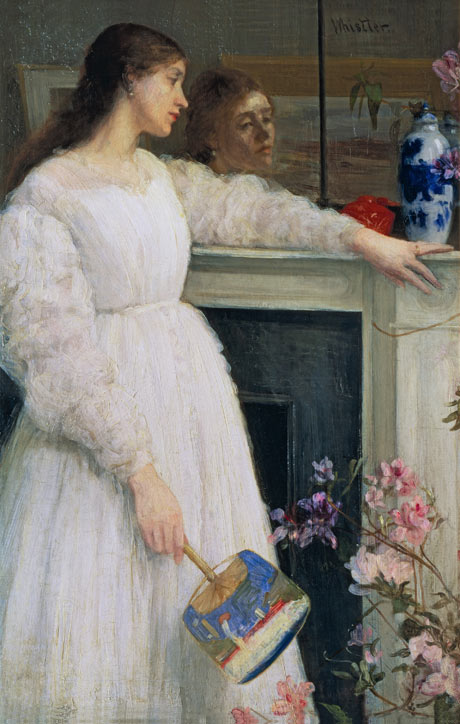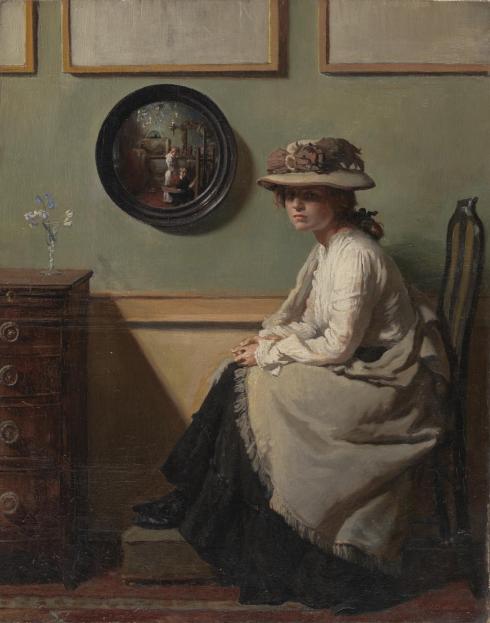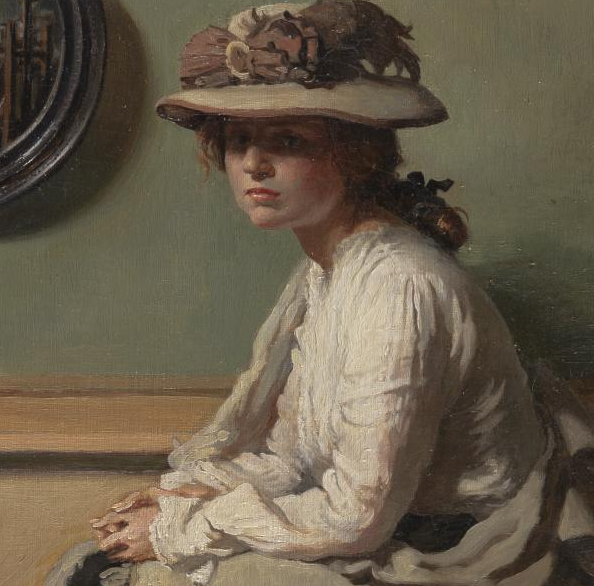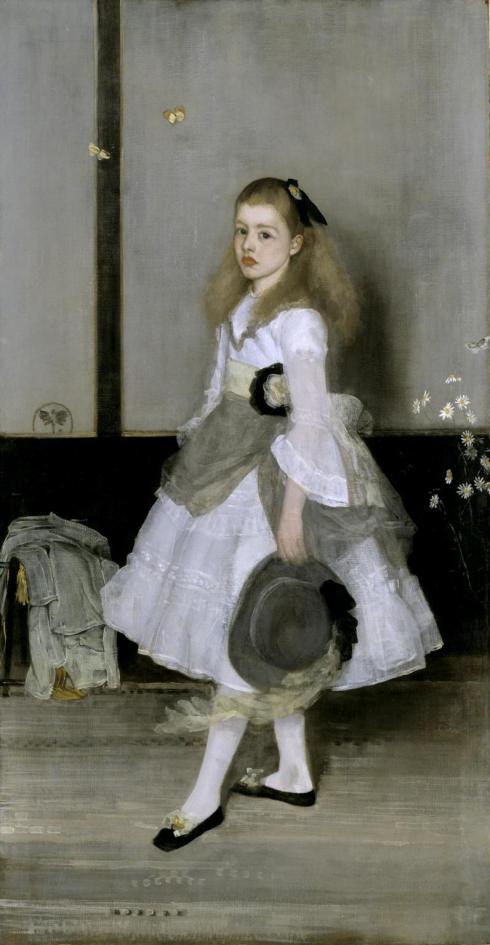It’s impossible not to love this painting; it has a meditative, dreamy aura, wistful lady wearing a beautifully painted white dress, and delicate pink flowers, hinting at Whistler’s appreciation of Japanese art and culture.
 James Abbot McNeill Whistler, Symphony in White no 2 (The Little White Girl), 1864
James Abbot McNeill Whistler, Symphony in White no 2 (The Little White Girl), 1864
Model for this ‘little white girl’ was an Irish beauty Joanna Hiffernan, a muse, model and a lover not only to Whistler but to Gustave Courbet as well, most famously in his painting ‘Sleep.’ Whistler’s biographers wrote of her: “She was not only beautiful. She was intelligent, she was sympathetic. She gave Whistler the constant companionship he could not do without.” Here, in Symphony in White no 2, Whistler painted her leaning against the mantelpiece in their love nest; a house they shared in Lindsey Row in Chelsea. She’s holding a Japanese fan in her hand. It’s interesting to note the ring on her left hand, but they were not married. There’s something ethereal about her; dressed in white gown that touches the ground, with long hair and a sad look in her eyes; she seems melancholic and detached from everything at the same time, as if she’s not really here, but is just passing through life without touching it, not allowing the harshness of reality to taint that beautiful whiteness of her muslin dress. If you close your eyes, you can imagine her slowly and elegantly walking across the room, then standing by the fireplace, her small hand barely touching the mantelpiece, while the other gently holds a fan. She is a silent Victorian woman living on the border of dreams and reality, like Millais’ Mariana, wrapped in the loneliness of her birdcage, longing for the imagined excitement of the real life out there. Or not. Perhaps she’s so engulfed in the sweetness of her daydreams and contemplation and doesn’t even walk to live the ‘real life’. At the same time, she knows that ‘dreams always end, they don’t rise up just descend’*, and this thought is the source of the wistfulness of her gaze that Whistler has so beautifully captured.
Here we see the typical elements of Japanese culture that can be found in many 19th century paintings; pink flowers, a fan, porcelain vase. Influence of Japanese Ukiyo-e prints, which were immensely popular at the time, is visible in the composition as well; you see how the picture looks like it’s cut on the ends, her wide sleeve on the left, pink azaleas at the bottom and her hand and the vase in the upper part of the painting. That’s something you don’t see in paintings of Academic Realism. Whistler is even said to have introduced Rossetti to Japanese art as a matter of fact.
Beautiful delicate pink azaleas are almost protruding into the composition, leaning their pink blossoms and delicate little leaves, as if they’re ready to listen to her sorrows and comfort her. ‘Don’t be sad, spring will soon come, and your woes will be gone‘, they seem to whisper. Joanna ignores them, her face turned away from the viewer. It’s the mirror which reveals the sadness and wistfulness of her gaze, and also the seascape that’s opposite the fireplace. She seems to be thinking:
“I am weary of days and hours,
Blown buds of barren flowers,
Desires and dreams and powers,
And everything but sleep.” (Swinburne)
Perhaps the most beautiful part of the painting, besides the flowers, is her dress which is painted in soft, almost transparent brushstrokes. Its gentle, dreamy appeal is contrasted with the strict, geometrical line of the fireplace. White is the hardest colours to paint, but Whistler shows a complete mastery over it, and the painting deserves its title ‘symphony’, for it is indeed a symphony in whites. In one painting below, Symphony in Flesh Colour and Pink: Portrait of Mrs Frances Leyland, whose beauty arrives from the subtlety of colours, you’ll see that mastery of white again, and the dress seems to flow effortlessly, like a river, decorated with the flowers that also serve as an interior decoration; it’s hard to say where reality ends and dream start because the more I look at these gorgeous studies in white, the more I am drawn into this ethereal, delicate world that Whistler has created, using just his brush and colours, not magic.
James Abbot McNeill Whistler (1834-1903) was an American artist, but after coming to England in 1859, he never returned to his homeland again, but instead divided his time between London and Paris, and nurtured friendships with other artists and writers on the each side of the Channel; Gaultier, Swinburne, Manet and Courbet to name a few. Whistler is famous for promoting ‘art for art’s sake philosophy’, and enraging Ruskin who emphasised the social, moralistic role of art. He was also known for giving his paintings musical names, such as ‘Symphony’ or ‘Nocturne’, which sometimes enraged the critics, but still fascinates the lovers of his art, myself included.
This painting, with Joanna’s ghost-like reflection in the mirror, inspired Swinburne to write these verses:
‘Glad, but not flushed with gladness,
Since joys go by;
Sad, but not bent with sadness,
Since sorrows die;
Deep in the gleaming glass
She sees all past things pass,
And all sweet life that was lie down and lie.‘
The critics have drawn a parallel between this painting and Ingres’ Portrait of Louise de Broglie, Countess d’Haussonville from 1845, which also has a lady standing by the mirror. Similar meditative mood, delicate whiteness, and touch of the East, can be found in many of Whistler’s paintings, here are a few:
 James Abbott McNeill Whistler, Symphony in White, No. 1: The White Girl, 1862 (Note: model is Joanna again)
James Abbott McNeill Whistler, Symphony in White, No. 1: The White Girl, 1862 (Note: model is Joanna again)
 James Abbott McNeill Whistler, Symphony in Flesh Colour and Pink: Portrait of Mrs Frances Leyland, 1872-1873
James Abbott McNeill Whistler, Symphony in Flesh Colour and Pink: Portrait of Mrs Frances Leyland, 1872-1873
 James Abbott McNeill Whistler, Le Princesse du Pays de la Porcelaine, 1863-65
James Abbott McNeill Whistler, Le Princesse du Pays de la Porcelaine, 1863-65
My interest in these paintings arose because of my longing for Spring, so here’s a beautiful haiku poem for the season that’s upon us. Spring, I am anxiously awaiting you, please come quickly!
“In these spring days,
when tranquil light encompasses
the four directions,
why do the blossoms scatter
with such uneasy hearts?” (Ki no Tomonori, c. 850-c. 904)
Tags: American painter, art, art for art's sake, haiku poems, James Abbot McNeill Whistler, Japan, Japonism, Joanna Hiffernan, longing for spring, lover, meditative, model, Muse, Painting, pink blossoms, pink flowers, Poem, Swinburne, Symphony, Whistler, White, white dress
 James Abbott Mcneill Whistler, Le Princesse du Pays de la Porcelaine, 1863-65
James Abbott Mcneill Whistler, Le Princesse du Pays de la Porcelaine, 1863-65













